|
⇐ Previous Article — Table of Contents — Next Article ⇒
New Energy Times home page
Krivit Review of Celani ICCF-16 Presentation
Appendix 18 to New Energy Times Report #3
By Steven B. Krivit
On Jan. 24, 2011, I learned that the scientific committee for the International Conference on Condensed Matter Nuclear Science (ICCF-16) decided two weeks before the start of the conference to permit two previously unscheduled talks about the Andrea Rossi experiment.
I wrote to Mahadeva Srinivasan, the conference chairman, and stated my concern that this was a highly irregular decision considering that Rossi's work had not been vetted in any scientific forum before the conference, or published in any journal, and that the abstract submission deadline had passed months earlier. Srinivasan explained his and his scientific committee's reasoning.
"There is a near-unanimous feeling that the Rossi and [Sergio] Focardi [Jan. 14, 2011] demo and claims deserve serious attention and scrutiny at the conference," Srinivasan said. "In the absence of a proper scientific paper from the original authors, this was the next best thing we could do: have short talks by someone who witnessed the demo and someone who is associated in some sense with their 'Journal.' There has been interest from the Indian dignitaries who will be present during the inaugural session of the conference, and they would like to be appraised a bit more on this development."
One of the talks was given by Michael Melich, who did not attend the January demonstration. Melich is on Rossi's "Board of Advisers." Melich trained as a theoretical physicist and claims to be gathering information about LENR on behalf of the U.S. government. His wife, Marianne Macy, attended the June 23, 2011, Defkalion press conference in Athens.
Defkalion is the Greek company to which Rossi has licensed his claimed technology. In January, Melich and Macy wrote and distributed reports through Jed Rothwell's Web site promoting Rossi's device. On Macy’s way back from Greece, she stopped to see "cold fusion" co-discoverer Martin Fleischmann at his home in England. She wrote about Fleischmann’s happiness in seeing the Defkalion press conference as well as a YouTube video by Nobel laureate Brian Josephson promoting Rossi's discovery.
In February at ICCF-16, Melich explained in his talk that he had been invited to attend the January Rossi demonstration but that he did not attend because he was not provided with a technical report in advance. Melich spoke for 10 minutes at ICCF-16 but said little.
Unlike Melich, Francesco Celani was a witness to the January demonstration. Celani is a nuclear physicist and works at the Italian National Institute of Nuclear Physics in Frascati. He is also the vice president of the International Society for Condensed Matter Nuclear Science. Celani was clearly familiar with the Rossi apparatus, and he presented an informative report.
However, I was not able to appreciate Celani's talk fully when I heard it because of the poor description that Rossi, Focardi and Giuseppe Levi had given of the device. Only after I had seen the Rossi apparatus myself was I able to understand fully the general idea of the device. Readers may wish to download Celani's full presentation.
People in the LENR field have responded to the Rossi claim in a variety of ways.
In March, a person well-known to New Energy Times advised me that Melich had contacted that person about an offer to invest in Rossi's device. There was no prospectus or sales pitch, just an offer "to get in,” according to the source.
William Collis, the executive secretary of the International Society for Condensed Matter Nuclear Science, mentioned pressure to silence honest skeptics. (See his opinion article). Some of that pressure has come from Josephson. According to one well-qualified person who has made significant contributions to understanding the facts about the Rossi claims, Josephson labeled him a "denier" after he began asking critical questions.
Let's look at selected text and images from Celani's presentation.
Here is what Celani wrote on Page 3 of his presentation:
- The experiment, at the beginning, didn’t start properly because the main heater had catastrophic failure.
|
- After some (chaotic) “work” (and the large [number of] people waiting in the main room making noisy and “bitter” comments), at the end, the reactor was started.
|
- The expected self-sustaining regime (input electric power strongly reduced from kW level to less that 100W), as claimed several times before by Rossi and Focardi, this time was not possible to be operated. |
|
As we learned later, the "catastrophic failure" was caused by a failed connector going to the main heating resistor. Luckily, the Rossi group was able to operate the device on the secondary heater alone. Levi, although he published conclusions for that experiment, did not publish any temperature data for that experiment. He wrote in his report that the data had been "lost." In my interview with Levi on June 14, he provided more information.
"In the second test, in the January test, data were lost," Levi said. "Also, I have written a report without having the real — because Rossi has switched off his computer."
All that remains available are some photos and video clips of the computer screen that show the temperature readouts.
Celani's slide indicates that Rossi had claimed to Celani and other people that his experiment had the capacity to run in a self-sustaining mode. Rossi called it "self-sustaining"; it is not Celani's term.
Technically, however, if Rossi runs the experiment with an electrical input "at less than 100W," it is not zero input, and thus it is not "self-sustaining." When I met Levi in Bologna, he too used the term "self-sustaining" to describe a phase of the Dec. 16, 2010, experiment that ran for almost 15 minutes on 10 Watts of power. But as my forthcoming video interview of Levi shows, Levi has had difficulty providing facts for or remembering key details to support his "self-sustaining" claim.
To the Rossi group's slight credit, an input of less than 100W might be loosely interpreted as "self-sustaining" if the measurements of the claimed output of multi-kilowatts were remotely correct. But the available facts do not support the claim of multi-kilowatt energy gain.
Let's go back to Page 3 of Celani's presentation:
- According to previous information, the same reactor and the same material SURELY worked very well all the day before (i.e. Jan. 13, [with an energy] gain of 100-200, self-sustaining regime possible) and the morning of Jan. 14, although at reduced performances (maximum gain of 30-40). |
We can see from Celani's emphasis that Rossi had made the claim that this same reactor had operated fine the day before and the morning of the Jan. 14 test and that it had produced 100 to 200 times more heat than the power from the electricity going into it.
According to Celani, Rossi claimed that the public demonstration on Jan. 14 produced an excess-heat ratio of 30-40 times. After the April experiments Rossi performed with journalist Mats Lewan, Rossi began stating that the expected energy gain was more along the lines of six times the heat input. Also, in my interview with Rossi on June 15, I asked Rossi why the experiments this year produced two orders of magnitude less energy than the experiments he report in his March 2010 paper. He said the reason was that his earlier experiments used a larger device but using that device with a public demonstration was too dangerous.
There is an inconsistency. Rossi has claimed that experiments he reported in his March 2010 paper and the experiment he performed on Jan. 13, 2011, and the morning of Jan. 14, 2011, produced an energy gain of 100-200 times. Rossi has claimed that the reactor which produced an excess heat gain of 100-200 times is too dangerous to use in a public demonstration. Yet that is the same scale device he attempted to demonstrate publicly in the afternoon on Jan. 14, 2011.
Here is Celani's page 6:
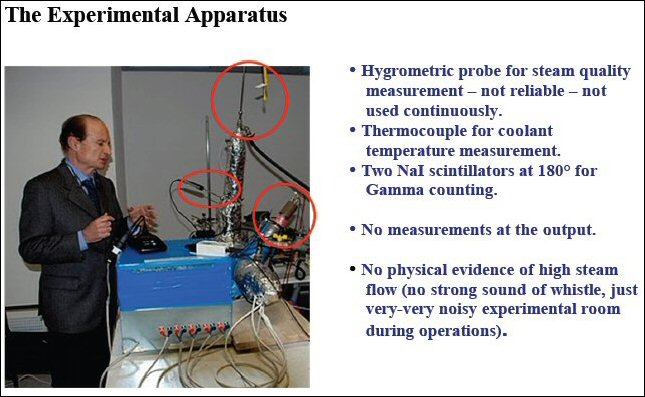
We can see that, as early as Feb. 7, Celani had recognized the most crucial concerns about the Rossi experiment. Most people, including me, failed to immediately appreciate and understand what Celani had recognized and was reporting.
In the first bullet item above, he indicates that he understood the problem with the Rossi group's efforts to measure steam quality. I do not know whether Celani specifically knew that the Rossi group was using the wrong instrument to measure steam quality or whether Celani simply had a general awareness of the problem. Regardless, he clearly understood that, even if it was the correct device, the intermittent readings were insufficient.
His third bullet item reveals his awareness of the primary inadequacy of the experiment. The Rossi group was measuring the input power (electrical energy) but not measuring the output power. They were making extraordinary claims of a power gain based not on a measurement but on an interpolation, at best.
In his fourth bullet item, "no physical evidence," he was clearly aware of the very serious visible observation suggesting that the excess-heat output was orders of magnitude less than what was claimed.
On Page 7 of his slides, Celani noted an inconsistency. He stated that the Rossi group had claimed the experiment produced steam for 40 minutes; however, as he notes, the graph from Levi's report shows only about 20 minutes of steam production.
On Page 8, Celani speaks critically about Levi's reported thermal balance:
- Very little information, incomplete measurements, questionable assumptions (like complete evaporation). |
Celani clearly recognized the weakest part of Rossi and Levi's claim: the assumption of complete evaporation of the water.
As an experienced LENR researcher, Celani recognized the fundamental mistake, as he called it, of the Rossi group. Celani's slides below give a very clear picture of this. Mitch Randall, a New Energy Times contributor, independently recognized and explained the problem.
"If you are trying to measure the performance of a "black box," you should not use a measurement from within the black box," Randall wrote.
But in the Rossi experiment, the problem is far worse than just attempting to measure from within the black box. As other analyses in this report show, the measurements of temperature and steam were wholly inadequate for the task.
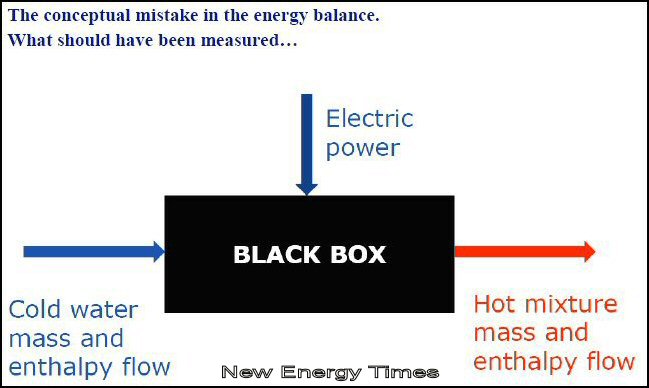
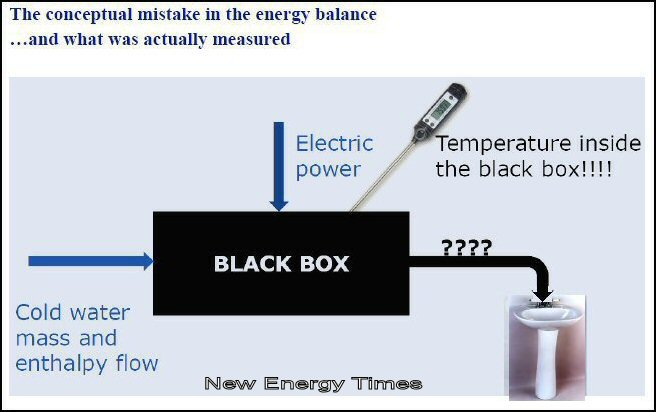
Celani expressed his concern that even a tiny number of water droplets carried off in the water vapor (steam) can give an incorrect impression of heat production, even several orders of magnitude.
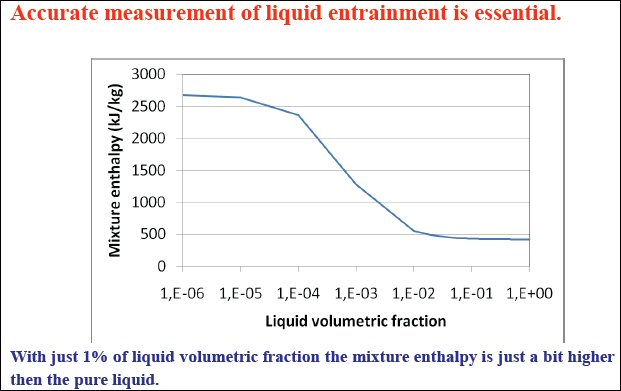
Rossi and Levi claimed to have measured the steam quality by mass. (Never mind that they used the wrong instrument.) Swedish professor Sven Kullander, a guest who visited and observed Rossi's device, told me, however, that he thought the steam was measured by volume. The other Swedish professor who visited, Hanno Essén, told me that he based his evaluation of the steam quality on what he was told by Rossi and Levi as well as on his personal observations of the volume of steam and liquid output.
Because water expands 1,600 times when it turns into steam, even a small flow of water immediately exiting the Rossi device, mixed with the steam, would support Celani's concern and disprove the bulk of the Rossi group's excess-heat claims.
Last but not least, Celani reported — again, on or before Feb. 7 — that he had made abundantly clear to Rossi both publicly and privately at least one method Rossi could use to unambiguously show a proper heat balance; see the last sentence in slide 14 below.
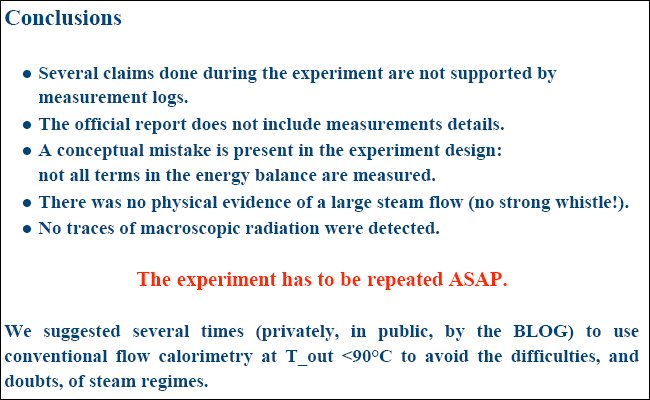
On Jan. 25, Celani sent an e-mail to Rossi, copied to me, Focardi and members of the LENR research field, with some of Celani's greatest concerns. Rossi responded the same day. Celani then put the finishing touches on his conference presentation.
But before Celani gave his presentation at ICCF-16, on Jan. 31, Rossi sent an exciting announcement by e-mail to members of the LENR research field. Rossi said that he would chain 100 10kW reactors in series and parallel to make a 1 MW reactor. He did not, apparently, explain how 100 steam-producing reactors could be aggregated effectively in this way.
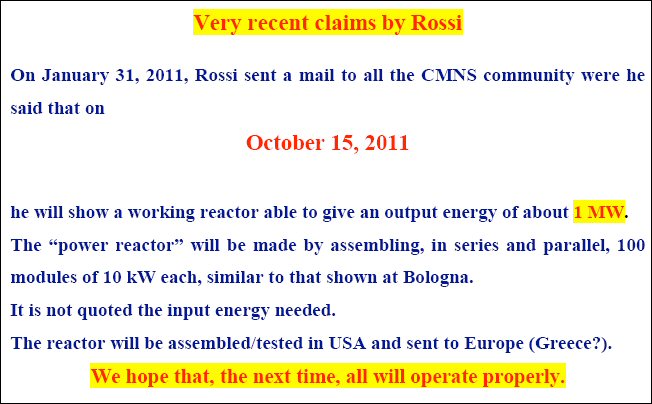
Brief Biography of Steven B. Krivit
Steven B. Krivit has performed investigative science journalism in the low-energy nuclear reactions research field for 10 years. He is the senior editor and publisher of New Energy Times. He also has published with John Wiley & Sons and Elsevier, among others.
⇐ Previous Article — Table of Contents — Next Article ⇒
| 
